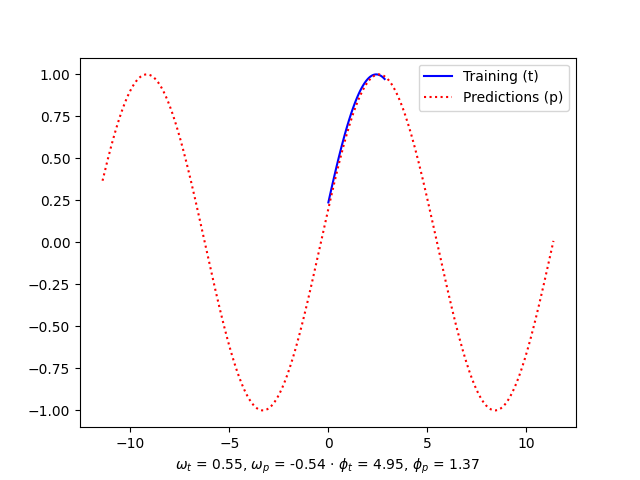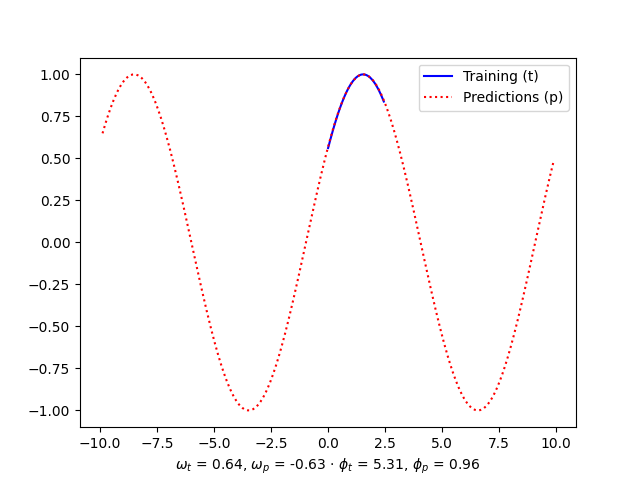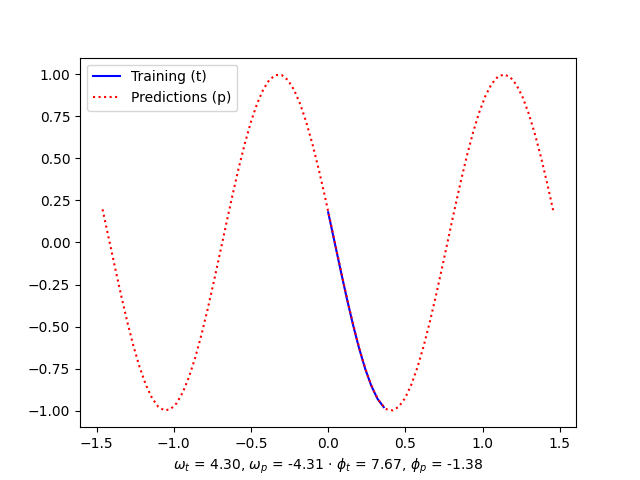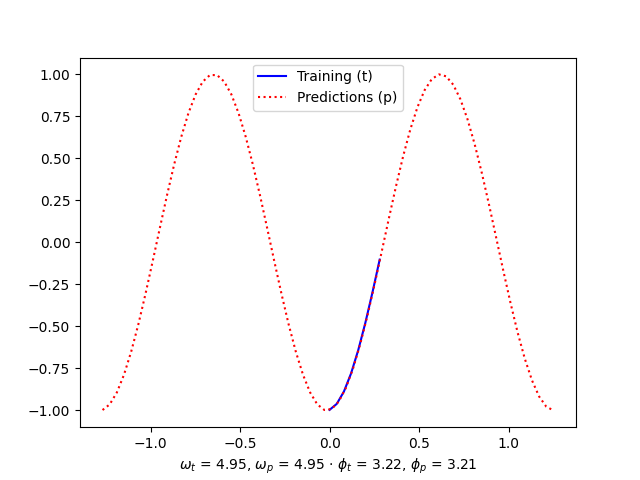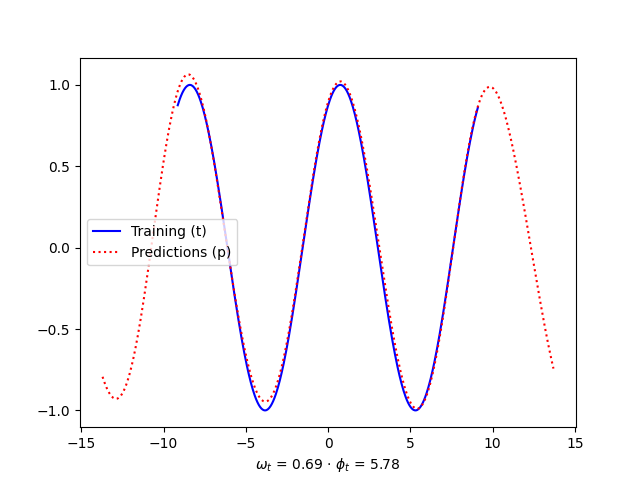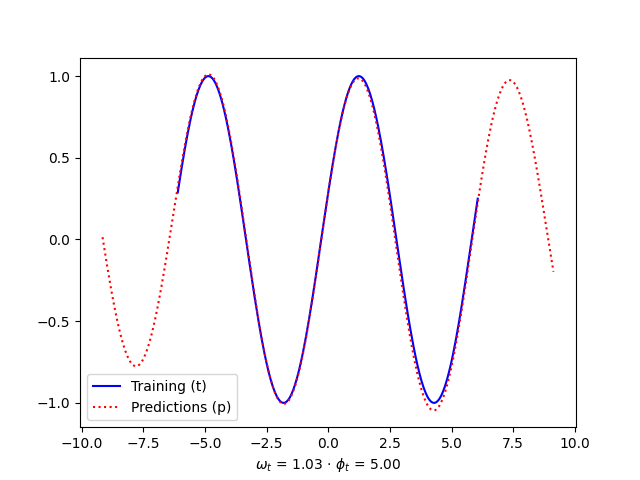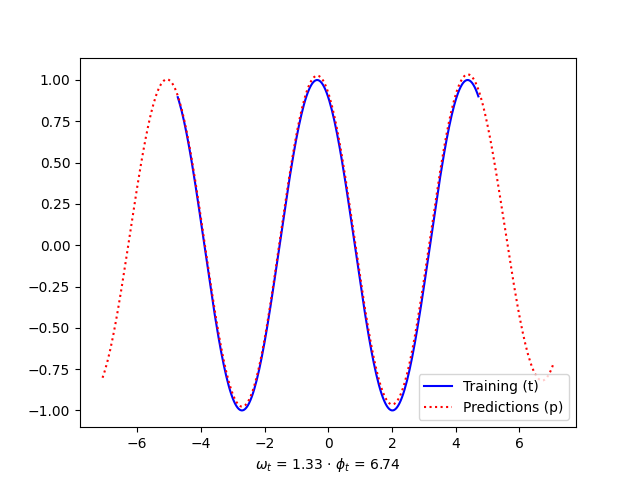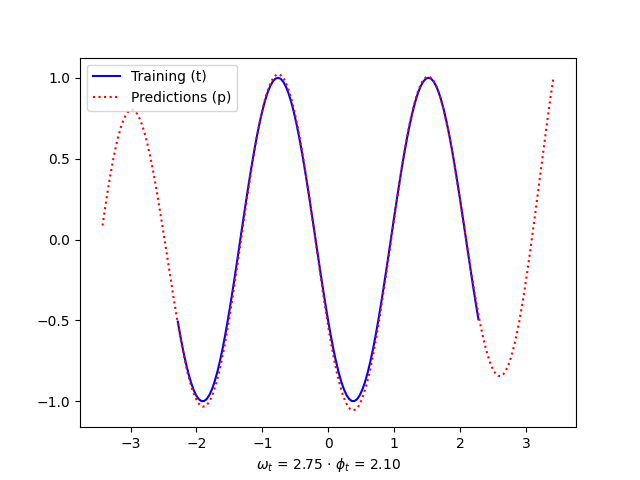This project contains a set of crazy layers that I created while learning Tensorflow. The layers in this repository shouldn't be considered ready for production and you shouldn't rely on their principles. These are just fun experiments!
This repository is a natural continuation of my Hello World neural network example.
In this exercise I generate a sinusoid (with a random angular velocity and a random phase) and then use a model with a custom Cosine layer to estimate the parameters.
import numpy as np
import matplotlib.pyplot as plt
from experimental_layers.datasets import RandomSinusoid
from experimental_layers.models import SinusoidalLayerModel
# Prepare the training data
sinusoid = RandomSinusoid()
x_train, y_train = sinusoid.get()
# Train the model
model = SinusoidalLayerModel()
model.train(x_train, y_train)
# Test the model
x_validate, y_validate = sinusoid.get(-2, 2)
y_predicted = model.predict(x_validate)
# Plot the results
plt.plot(
x_train,
y_train,
color='blue', label='Training (t)')
plt.plot(
x_validate,
y_predicted,
color='red', linestyle='dotted', label='Predictions (p)')
angular_velocity_label = "$\omega_t$ = {:.2f}, $\omega_p$ = {:.2f}".format(
sinusoid.angular_velocity,
model.get_angular_velocity())
phase_label = "$\phi_t$ = {:.2f}, $\phi_p$ = {:.2f}".format(
sinusoid.phase,
model.get_phase())
plt.xlabel(angular_velocity_label + " · " + phase_label)
plt.legend()
plt.savefig("images/sinusoid-wt-{:.2f}-pt-{:.2f}.png".format(
sinusoid.angular_velocity,
sinusoid.phase))
plt.show()Here are some examples of results generated with the code above.
Note that for the code to work properly the training samples must be cutted. In the examples, the data used for the training is just a tiny fraction of the period of the sinusoid being studied. This is due to the fact that if we add one or more entire periods, the loss function would suffer trying to make estimates.
As the neural network has a sinusoidal output layer, it only knows how to predict sinusoids. What means that this approach wouldn't even try to approximate other types of periodical functions.
If you check carefully the numbers that we extracted from the predictions, you'll find two almost inevitable issues:
- the angular velocity was found sometimes with negative sign,
- the phase can be found with added (or subtracted) multiples of
$2 \pi$ .
A much more flexible approach is the one suggested in Neural Networks Fail to Learn Periodic Functions and How to Fix It, by Liu Ziyin, Tilman Hartwig and Masahito Ueda (see https://arxiv.org/abs/2006.08195):
As a fix of this problem, we propose a new activation, namely,
$x+sin2(x)$ , which achieves the desired periodic inductive bias to learn a periodic function while maintaining a favorable optimization property of the ReLU-based activations.
import numpy as np
import matplotlib.pyplot as plt
from experimental_layers.datasets import RandomSinusoid
from experimental_layers.models import SnakeActivationModel
# Prepare the training data
sinusoid = RandomSinusoid()
x_train, y_train = sinusoid.get(-2, 2)
# Train the model
model = SnakeActivationModel()
history = model.train(x_train, y_train, epochs=100, learning_rate=0.01)
# Test the model
x_validate, y_validate = sinusoid.get(-3, 3)
y_predicted = model.predict(x_validate)
# Plot the results
plt.plot(
x_train,
y_train,
color='blue', label='Training (t)')
plt.plot(
x_validate,
y_predicted,
color='red', linestyle='dotted', label='Predictions (p)')
angular_velocity_label = "$\omega_t$ = {:.2f}".format(
sinusoid.angular_velocity)
phase_label = "$\phi_t$ = {:.2f}".format(
sinusoid.phase)
plt.xlabel(angular_velocity_label + " · " + phase_label)
plt.legend()
plt.savefig("images/snake-wt-{:.2f}-pt-{:.2f}.png".format(
sinusoid.angular_velocity,
sinusoid.phase))
plt.show()Here are some examples of results generated with the code above. Note how, in this cases we didn't have to cut the data shown during the training to pieces tinier than a period.
This project was written with Poetry. The following instructions should be sufficient for you to start using it.
git clone https://github.com/elcapo/experimental_layers.git
cd experimental_layers
poetry installNote that you'll need to install git, python and poetry to get this working.
Once installed, use Poetry's shell to interact with the package.
poetry shell # then
python # and have fun